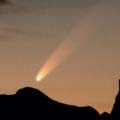
|
It was 4.5 mag on Dec. 26 (Piotr Guzik), then it is brightening rapidly. It has finally become brighter than 0 mag on Jan. 6, and already brightened up to -2.2 mag on Jan. 10 (Seiichi Yoshida). Now it is extremely difficult to observe it. However, because the comet is very bright, it is visible with naked eyes in the extremely low sky in the twilight if the sky condition is excellent. The comet is easily visible with a tail through binoculars. It looks as a great comet in Michael Jager and Gerald Rhemann's image on Jan. 7, and Alessandro Dimai's image on Jan. 8. It will pass only 0.17 A.U. from the sun in mid January, and reach to -3 mag. It will be also visible in the SOHO/LASCO images in mid January. It will pass only 40 arcmin from Mercury on Jan. 14 at 16 o'clock (UT). Because the comet is moving southwards, it will be unobservable in the Northern Hemisphere soon. In the Southern Hemisphere, it appears at around 2 mag in late January, then it keeps observable while fading gradually. In the Northern Hemisphere, it will never be observable again.
Date(TT) R.A. (2000) Decl. Delta r Elong. m1 Best Time(A, h)
Jan. 6 19 4.94 -7 43.5 1.138 0.314 14 1.3 3:08 (305,-29)
Jan. 13 19 55.69 -16 49.1 0.849 0.171 6 -2.0 20:59 ( 52,-17)
|
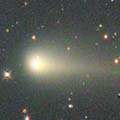
|
It reached up to 9.3 mag between October and November (Oct. 27, Juan Jose Gonzalez). It had been observable in excellent condition. But it is fading now. It has already faded down to 10.7 mag (Dec. 23, Seiichi Yoshida). However, it keeps observable after this until May when it fades down to 16 mag. It will be visible visually for a long time until around March.
Date(TT) R.A. (2000) Decl. Delta r Elong. m1 Best Time(A, h)
Jan. 6 2 53.65 4 8.3 1.068 1.745 116 10.9 21:02 (153, 47)
Jan. 13 3 4.14 5 3.1 1.141 1.766 112 11.2 20:59 (149, 45)
|
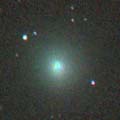
|
When it approached to the earth between from November to early December, it reached up to 8.5 mag as a very large diffuse object with a diameter larger than 10 arcmin (Nov. 23, Peter Bus). It kept 9 mag and observable in excellent condition for a long time since mid October until mid December. However, now it is fading, down to 10.8 mag (Dec. 23, Yoshimi Nagai). It will fade out rapidly after January. It will be fainter than 14 mag, too faint to see visually, in February. It will set down in the evening sky at 17 mag in March.
Date(TT) R.A. (2000) Decl. Delta r Elong. m1 Best Time(A, h)
Jan. 6 2 7.53 44 50.8 1.175 1.837 116 11.2 21:02 (159, 6)
Jan. 13 1 44.53 41 39.7 1.376 1.895 105 11.9 20:59 (150, 5)
|
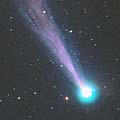
|
After it kept 5.5-6.0 mag from early October to mid October, it suddenly brightened in outburst on Oct. 24, and reached up to 4.2 mag on Oct. 25 (Maik Meyer). It became easily visible with naked eyes, and a very long tail of 5 degrees was visible with binoculars. But now it is fading, and it has already faded down to 10.4 mag (Dec. 24, Mike Linnolt). It will be too low in the evening sky to observe soon. It will appear in the morning sky again at 15-16 mag in May. Then it keeps observable until it becomes fainter than 18 mag in autumn.
Date(TT) R.A. (2000) Decl. Delta r Elong. m1 Best Time(A, h)
Jan. 6 21 8.25 -4 8.8 2.606 1.885 34 11.4 21:02 ( 78, -9)
Jan. 13 21 18.88 -5 1.9 2.771 1.979 29 11.8 20:59 ( 76,-11)
|
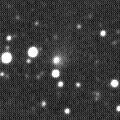
|
It was too low in the evening to observe in October and November. But it is getting higher in the morning sky again. Now it is 12.2 mag (Dec. 28, Juan Jose Gonzalez). It keeps 12-13 mag until March and visible visually for a long time.
Date(TT) R.A. (2000) Decl. Delta r Elong. m1 Best Time(A, h)
Jan. 6 17 13.04 30 54.9 2.383 2.073 59 12.6 3:08 (251,-29)
Jan. 13 17 29.18 34 42.4 2.336 2.098 63 12.6 3:16 (245,-27)
|

|
First return of a new bright periodic comet observed at 9 mag in 2001. But it has not been recovered yet. The condition of this apparition is bad. It keeps locating very low in the evening. But it is expected to reach up to 11 mag in February and March. However, it was not detected on Dec. 27, fainter than 16.5 mag (Filip Fratev). So, it seems to be much fainter than this ephemeris in fact.
Date(TT) R.A. (2000) Decl. Delta r Elong. m1 Best Time(A, h)
Jan. 6 20 54.61 -9 58.6 1.940 1.179 28 13.7 21:02 ( 72, -8)
Jan. 13 21 19.50 -8 51.6 1.895 1.124 27 13.2 20:59 ( 73, -9)
|

|
In this season, it has been bright as 12-13 mag and visible visually since it appeared in the morning sky in early July. Now it is 13.1 mag (Dec. 22, Seiichi Yoshida). Diffuse, and not easy to see visually. However, it looks very large on CCD images, with a diameter of about 2 arcmin. It keeps observable in good condition until March.
Date(TT) R.A. (2000) Decl. Delta r Elong. m1 Best Time(A, h)
Jan. 6 3 45.66 29 52.1 5.135 5.870 134 13.3 21:02 (175, 25)
Jan. 13 3 44.27 29 35.8 5.220 5.872 127 13.4 20:59 (169, 25)
|
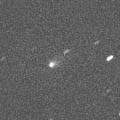
|
It had been unobservble for a long time. When it appeared again in the morning sky, it has showed a cometary activity and it has become much brighter than expected. It was visible visually on Oct. 31 at 13.7 mag (Seiichi Yoshida). It is bright as 13.8 mag still now (Dec. 29, Katsumi Yoshimoto). It keeps 13-14 mag until March. It is observable in good condition in the Southern Hemisphere. However, it will not be observable in the Northern Hemisphere soon.
Date(TT) R.A. (2000) Decl. Delta r Elong. m1 Best Time(A, h)
Jan. 6 13 24.27 -47 18.1 2.126 2.024 70 13.6 3:08 (304, 52)
Jan. 13 13 41.14 -50 33.2 2.103 2.040 72 13.6 3:16 (310, 55)
|
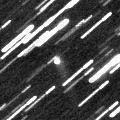
|
Now it is 14.6 mag (Dec. 23, Seiichi Yoshida). Almost asteroidal. It did not brighten at all since early September. Although the slight cometary activity was detected in late July, it became completely stellar soon. Its tail became visible again in late October, however, it turned to be stellar again soon. Finally it has passed the perihelion, keeping almost asteroidal. In the Northern Hemisphere, it keeps good condition after this. It keeps locating high until spring. It is fainter than this ephemeris recently.
Date(TT) R.A. (2000) Decl. Delta r Elong. m1 Best Time(A, h)
Jan. 6 23 9.42 45 15.7 0.779 1.228 87 13.8 21:02 (136,-14)
Jan. 13 23 52.17 46 45.6 0.760 1.236 89 13.7 20:59 (139,-12)
|
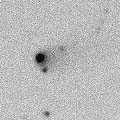
|
It has been visible at 13.5 mag for a long time since 2005 autumn until 2006 spring. Now it is fainter than last year by 1 mag, however, it is still visible visually at 14.2 mag (Dec. 22, Seiichi Yoshida). It keeps observable in excellent condition until April.
Date(TT) R.A. (2000) Decl. Delta r Elong. m1 Best Time(A, h)
Jan. 6 13 9.59 22 6.2 5.359 5.574 97 14.4 3:08 (224, 19)
Jan. 13 13 11.59 22 12.2 5.282 5.593 103 14.4 3:16 (217, 23)
|

|
It is observable in good condition in the Southern Hemisphere. But it is not observable until January in the Northern Hemisphere. It was discovered at 17.5 mag in May. Then it has not been brightening well. It is 16.5-17 mag still in December. It will be observable also in the Northern Hemisphere in the evening low sky from January to March, however, it will be fainter than 15 mag.
Date(TT) R.A. (2000) Decl. Delta r Elong. m1 Best Time(A, h)
Jan. 6 2 51.50 -49 18.7 2.433 2.603 88 15.1 21:02 ( 39, 70)
Jan. 13 2 41.81 -44 52.6 2.462 2.583 85 15.1 20:59 ( 57, 67)
|

|
Now it is 15.5 mag (Dec. 3, Ken-ichi Kadota). It is observable at 15.5-16 mag until spring. But, in the Northern Hemisphere, it locates somewhat low at 20-30 degree high.
Date(TT) R.A. (2000) Decl. Delta r Elong. m1 Best Time(A, h)
Jan. 6 6 29.78 -34 52.6 3.311 3.920 121 15.5 23:25 (180, 90)
Jan. 13 6 12.74 -34 45.8 3.324 3.913 120 15.5 22:40 (180, 90)
|
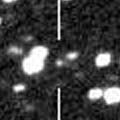
|
It tends to become brightest about 4 months after the perihelion passage. In this apparition, it was 17.6 mag in late July around the perihelion passage (July 23, Filip Fratev), however, it brightened up to 14.1 mag and became visible visually on Dec. 23 (Seiichi Yoshida). But it will start fading after this. Although it keeps a good condition for a long time, it will be fainter than 18 mag in March.
Date(TT) R.A. (2000) Decl. Delta r Elong. m1 Best Time(A, h)
Jan. 6 5 26.58 18 49.2 1.322 2.258 156 15.9 22:23 (180, 36)
Jan. 13 5 23.39 19 22.3 1.391 2.290 148 16.1 21:53 (180, 36)
|
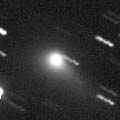
|
It was still visible visually at 14.2 mag on Oct. 31 (Seiichi Yoshida). However, it has already faded down to 15.8 mag (Dec. 15, Ernesto Guido and Giovanni Sostero). It keeps a good contition until spring, while the comet will be fading gradually.
Date(TT) R.A. (2000) Decl. Delta r Elong. m1 Best Time(A, h)
Jan. 6 9 57.36 25 13.9 3.312 4.122 140 16.0 2:58 (180, 30)
Jan. 13 9 52.82 25 34.0 3.317 4.188 148 16.1 2:26 (180, 29)
|
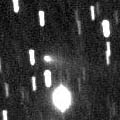
|
It was expected to reach to 13 mag in winter. But actually, it was 15.7 mag at best (Dec. 5, Ken-ichi Kadota), much fainter than expected. It will fade out rapidly after this. It will be fainter than 18 mag in February.
Date(TT) R.A. (2000) Decl. Delta r Elong. m1 Best Time(A, h)
Jan. 6 8 15.59 52 11.4 0.755 1.670 147 16.0 1:16 (180, 3)
Jan. 13 8 10.62 55 48.6 0.787 1.691 145 16.2 0:44 (180, -1)
|
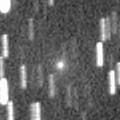
|
Although it was so faint as 20.7 mag on Aug. 2 (P. Birtwhistle), it brightened rapidly as expected, and reached up to 15.7 mag on Nov. 15 (Ken-ichi Kadota). After it passed the perihelion, it has not started fading yet. It is bright as 16.1 mag still now (Dec. 19, Ken-ichi Kadota). In the Northern Hemisphere, it keeps a good condition for a long time after this. It will be observable at 16-17 mag for a while.
Date(TT) R.A. (2000) Decl. Delta r Elong. m1 Best Time(A, h)
Jan. 6 4 35.47 69 34.6 0.838 1.637 127 17.0 21:33 (180,-15)
Jan. 13 4 40.84 68 43.0 0.892 1.671 125 17.2 21:11 (180,-14)
|
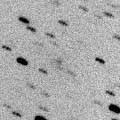
|
Recovered after 15 year blank. The condition is good in this return. It was expected to reach to 13.5 mag in November. But actually, it was 15.0 mag at best (Dec. 2, Ken-ichi Kadota), fainter than expected. Now it is fading rapidly. It has already faded down to 17.1 mag (Dec. 29, Ken-ichi Kadota).
Date(TT) R.A. (2000) Decl. Delta r Elong. m1 Best Time(A, h)
Jan. 6 0 1.58 6 6.9 1.026 1.261 77 17.1 21:02 (113, 20)
Jan. 13 0 26.40 10 48.2 1.082 1.304 78 17.8 20:59 (117, 17)
|

|
It will be brightening gradually at the high altitude until 2007 spring, while it brightens up to 16 mag. Then it keeps 15.5-16 mag for one year and a half until 2008 summer. However, because the comet moves southwards, it is only observable until 2007 June in the Northern Hemisphere.
Date(TT) R.A. (2000) Decl. Delta r Elong. m1 Best Time(A, h)
Jan. 6 11 12.56 5 39.2 3.638 4.194 118 17.2 3:08 (204, 47)
Jan. 13 11 11.79 5 8.5 3.496 4.144 125 17.1 3:16 (191, 49)
|

|
Now it is 16.8 mag (Dec. 29, Katsumi Yoshimoto). It is outside of Jupiter's orbit. So it keeps 17 mag for a long time until 2007 summer. It keeps locating high and observable in good condition for a long time after this because it moves in the northern sky.
Date(TT) R.A. (2000) Decl. Delta r Elong. m1 Best Time(A, h)
Jan. 6 14 46.67 37 36.2 7.138 7.130 85 17.1 3:08 (229, -7)
Jan. 13 14 48.40 37 45.6 7.077 7.143 89 17.1 3:16 (224, -2)
|
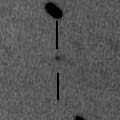
|
Now it is 17.0 mag (Dec. 17, Ken-ichi Kadota). The perihelion passage is in 2008. It will be observable for several years after this at around 17 mag. But it may fade out rapidly just after the perihelion passage.
Date(TT) R.A. (2000) Decl. Delta r Elong. m1 Best Time(A, h)
Jan. 6 4 16.22 11 31.9 3.910 4.688 138 17.2 21:13 (180, 43)
Jan. 13 4 14.08 11 50.4 3.974 4.677 130 17.2 20:59 (175, 43)
|
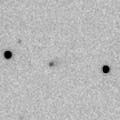
|
It reached to 16 mag in early 2006. Now it is 17.3 mag (Dec. 2, Ken-ichi Kadota). It will be fading very slowly from 17 mag to 18 mag until 2007 summer. In the Northern Hemisphere, it keeps locating high.
Date(TT) R.A. (2000) Decl. Delta r Elong. m1 Best Time(A, h)
Jan. 6 14 14.20 30 50.2 5.523 5.574 87 17.2 3:08 (229, 2)
Jan. 13 14 17.45 31 1.3 5.464 5.598 92 17.2 3:16 (224, 7)
|
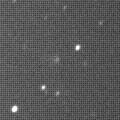
|
It reached up to 16 mag in 2005 summer in the Southern Hemisphere. Now it is 17.2 mag (Dec. 4, Ken-ichi Kadota). The brightening was very slow, and the fading seems also very slow. It will keep 17 mag until January after this. But then it will turn to fade out rapidly, and will be fainter than 18 mag in February.
Date(TT) R.A. (2000) Decl. Delta r Elong. m1 Best Time(A, h)
Jan. 6 4 58.99 -18 9.8 4.522 5.195 128 17.2 21:56 (180, 73)
Jan. 13 4 55.51 -16 59.8 4.609 5.234 124 17.3 21:25 (180, 72)
|
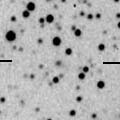
|
It keeps 17 mag until January. Then it keeps observable util April when it becomes fainter than 18 mag.
Date(TT) R.A. (2000) Decl. Delta r Elong. m1 Best Time(A, h)
Jan. 6 3 59.98 51 1.9 3.073 3.825 134 17.3 21:02 (179, 4)
Jan. 13 3 58.22 50 29.0 3.128 3.822 128 17.3 20:59 (175, 4)
|

|
It is observable in excellent condition at 17.5 mag in December and January. It will be fainer than 18 mag in March.
Date(TT) R.A. (2000) Decl. Delta r Elong. m1 Best Time(A, h)
Jan. 6 6 23.20 29 13.0 1.356 2.327 168 17.3 23:20 (180, 26)
Jan. 13 6 17.83 29 9.1 1.375 2.326 160 17.4 22:47 (180, 26)
|
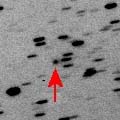
|
Now it is 16.6 mag (Dec. 2, Ken-ichi Kadota). Although it kept 16 mag for a while, it will start fading after this, and will be fainter than 18 mag in February.
Date(TT) R.A. (2000) Decl. Delta r Elong. m1 Best Time(A, h)
Jan. 6 11 0.40 -16 46.6 1.364 1.940 110 17.4 3:08 (216, 68)
Jan. 13 11 0.20 -18 34.6 1.339 1.978 115 17.6 3:16 (194, 73)
|

|
Peculiar asteroid moving along an orbit like a comet. It reaches up to 17.5 mag in mid January. But it will be fainter than 18 mag in February. It is observable in an excellent condition in the Northern Hemisphere.
Date(TT) R.A. (2000) Decl. Delta r Elong. m1 Best Time(A, h)
Jan. 6 7 33.63 22 18.1 1.687 2.666 173 17.6 0:34 (180, 33)
Jan. 13 7 28.92 22 45.5 1.670 2.653 177 17.5 0:02 (180, 32)
|

|
It was visible visually at 12 mag in last spring. Now it is 17.2 mag (Dec. 29, Katsumi Yoshimoto), brighter than this ephemeris. It will keep good condition for a while after this, but it will be fading gradually.
Date(TT) R.A. (2000) Decl. Delta r Elong. m1 Best Time(A, h)
Jan. 6 16 39.22 32 35.0 4.565 4.250 65 17.6 3:08 (246,-24)
Jan. 13 16 43.26 33 56.4 4.566 4.315 69 17.7 3:16 (241,-19)
|

|
Recovered at 19.3 mag on Nov. 18 (E. J. Christensen). It is a tiny comet, however, it will pass near, only 0.3 A.U., by the earth in February and will be 17 mag. It moves northern sky and it is observable in good condition in the Northern Hemisphere. However, it will be fade out soon, will be fainter than 18 mag in March.
Date(TT) R.A. (2000) Decl. Delta r Elong. m1 Best Time(A, h)
Jan. 6 1 0.74 19 40.5 0.334 1.072 96 17.9 21:02 (134, 19)
Jan. 13 0 51.97 26 52.5 0.322 1.037 90 17.7 20:59 (133, 9)
|

|
Now it is around the aphelion and faintest, but it is observed at 18 mag. It will be observable at 18 mag in good condition until March. It will be 13-14 mag and visible visually again in 2009. It will reach to 12.5 mag in 2010. But in the Northern Hemisphere, it will locate very low in the south at that time.
Date(TT) R.A. (2000) Decl. Delta r Elong. m1 Best Time(A, h)
Jan. 6 5 51.71 28 37.2 3.768 4.714 162 17.8 22:48 (180, 26)
Jan. 13 5 46.92 28 39.6 3.806 4.711 154 17.8 22:16 (180, 26)
|

|
It will reach up to 14 mag one year later, in next winter, when it will be observable in excellent condition in the Northern Hemisphere. Now it is only 18 mag. It will be lower in February, then it will be unobservable for a while until July.
Date(TT) R.A. (2000) Decl. Delta r Elong. m1 Best Time(A, h)
Jan. 6 0 33.25 14 27.0 4.173 4.257 88 17.9 21:02 (125, 20)
Jan. 13 0 36.92 14 31.0 4.229 4.207 82 17.9 20:59 (121, 16)
|

|
It was in major outburst unexpectedly and reached to 10.5 mag in its last appearance in 1999. However, it is faint in this apparition. Now it is 17.4 mag (Nov. 23, Ken-ichi Kadota). It will fade out gradually after this.
Date(TT) R.A. (2000) Decl. Delta r Elong. m1 Best Time(A, h)
Jan. 6 13 32.67 -14 8.3 2.172 2.200 78 18.0 3:08 (259, 40)
Jan. 13 13 40.39 -15 28.1 2.123 2.236 83 18.1 3:16 (255, 46)
|

|
It has been lost since its discovery in 1986. The condition is good in this return. In calculation, it was expected to be 14 mag from autumn to winter. But actually, it must be much fainter than expected. Although it has been listed up as an observable target since May, it has not been recovered yet. It was probably in outburst and brightened unexpectedly at the discovery. If it locates within 30 arcmin from the predicted position, it is fainter than 17.5 mag (Nov. 15, Michael Jager).
Date(TT) R.A. (2000) Decl. Delta r Elong. m1 Best Time(A, h)
Jan. 6 23 20.88 -2 43.8 1.604 1.482 64 18.7 21:02 ( 99, 17)
Jan. 13 23 42.43 -0 29.2 1.664 1.509 63 18.9 20:59 (101, 15)
|
|
![]()
 29P/Schwassmann-Wachmann 1
29P/Schwassmann-Wachmann 1 C/2005 YW ( LINEAR )
C/2005 YW ( LINEAR ) P/2006 HR30 ( Siding Spring )
P/2006 HR30 ( Siding Spring ) C/2003 WT42 ( LINEAR )
C/2003 WT42 ( LINEAR ) C/2006 K3 ( McNaught )
C/2006 K3 ( McNaught ) C/2005 EL173 ( LONEOS )
C/2005 EL173 ( LONEOS ) 84P/Giclas
84P/Giclas C/2005 E2 ( McNaught )
C/2005 E2 ( McNaught ) 76P/West-Kohoutek-Ikemura
76P/West-Kohoutek-Ikemura 112P/Urata-Niijima
112P/Urata-Niijima 181P/2006 U4 ( Shoemaker-Levy 6 )
181P/2006 U4 ( Shoemaker-Levy 6 ) C/2006 V1 ( Catalina )
C/2006 V1 ( Catalina ) C/2002 VQ94 ( LINEAR )
C/2002 VQ94 ( LINEAR ) 173P/2005 T1 ( Mueller 5 )
173P/2005 T1 ( Mueller 5 ) C/2004 D1 ( NEAT )
C/2004 D1 ( NEAT ) C/2004 L2 ( LINEAR )
C/2004 L2 ( LINEAR ) P/2005 SB216 ( LONEOS )
P/2005 SB216 ( LONEOS ) P/2006 U5 ( Christensen )
P/2006 U5 ( Christensen ) 114P/Wiseman-Skiff
114P/Wiseman-Skiff 2006 SV301
2006 SV301 C/2004 B1 ( LINEAR )
C/2004 B1 ( LINEAR ) 182P/2006 W2 ( LONEOS )
182P/2006 W2 ( LONEOS ) 65P/Gunn
65P/Gunn C/2006 S5 ( Hill )
C/2006 S5 ( Hill ) 52P/Harrington-Abell
52P/Harrington-Abell D/1986 W1 ( Lovas 2 )
D/1986 W1 ( Lovas 2 )![]()




















